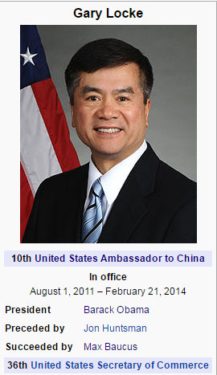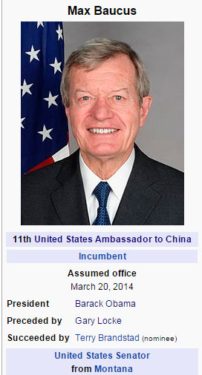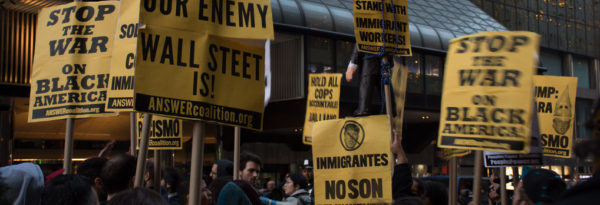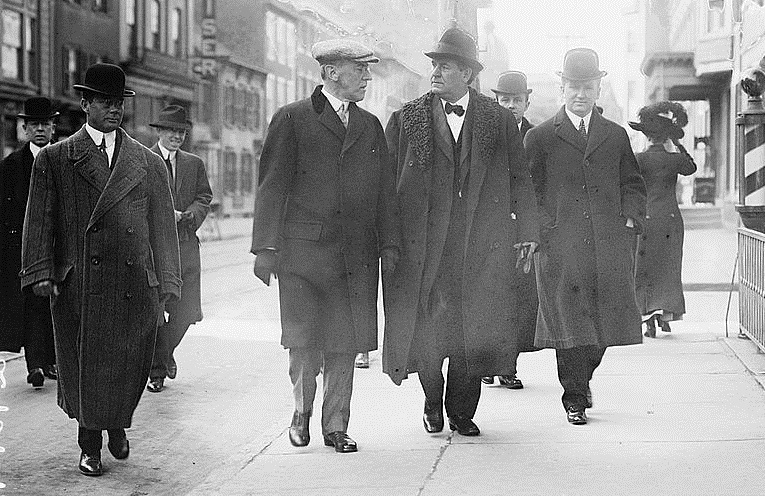Monthly Archives: December 2016
John Weaver hunches his angular frame over a Styrofoam cup of coffee in the basement cafeteria of the United States Senate and tries to explain what might seem–to an outsider–his peculiar political loyalties. Once a loyal Republican strategist who directed the presidential aspirations of über-conservative Phil Gramm and helped plot John McCain’s maverick primary run in 2000, he has since reregistered as a Democrat and severed consulting ties to all Republicans except McCain, for whom he still serves as chief strategist. “I only work for Democrats now,” he tells me. Noticing that he has overlooked the party affiliation of his most prominent advisee, I helpfully add: “And John McCain.” Weaver shrugs his shoulders and grins, “Oh, right.”
It’s easy to forget that the Arizona senator is not, in fact, a Democrat. In the past year he has stood against his party on so many prominent and contentious issues that his concurrences with GOP dogma have become more of an exception than a rule. In the conservative media, he has become a figure of vilification on par with Tom Daschle. Last fall, when his name came up in a meeting of House Republicans, he was booed. And it is no exaggeration to say that he has co-sponsored virtually the entire domestic agenda of the Democratic Party. One prominent Democrat enthuses, “He’s the leader of the loyal opposition.” Typically that role falls to a leader of the opposition party. But the most popular and effective champion of the Democratic Party’s values isn’t Tom Daschle. It’s John McCain. And at a moment when the party is casting about for a leader to define it against a popular president, and McCain is casting about for a home after his virtual expulsion from the GOP, there is an obvious solution to both dilemmas: John McCain ought to become a Democrat–and a presumptive front-runner for the party’s presidential nomination in 2004.
Source: The New Republic Online: What’s in a Name?
Trump picks trade advocate to be ambassador to China (New York Times)
Mr. Branstad, whose selection was first reported by Bloomberg News and confirmed on condition of anonymity on Wednesday by two people with direct knowledge, is close to President Xi Jinping, whom he has known for more than three decades. They met in 1985, when Mr. Branstad was serving his first term as governor of Iowa and Mr. Xi was a 31-year-old rural official in Hebei Province, studying modern American agriculture, including hog and corn farming in Iowa.
Mr. Branstad has courted China as governor, promoting his state’s farm goods. As ambassador, he would be tasked with managing a complex relationship that Mr. Trump has already indicated he is willing to shake up. The president-elect’s call with Taiwan’s president last week prompted criticism from Beijing, which considers it a breakaway province, and Mr. Trump responded with posts on Twitter attacking China for its trade practices and provocative moves in the South China Sea.
Trump picks Iowa Gov. Terry Branstad — a ‘friend’ of China’s leader — as Beijing ambassador (Washington Post)
Branstad has extensive ties to China and a personal friendship with Chinese President Xi Jinping that dates back decades. If confirmed, the move could go some way to reassure China’s leadership that Trump understands the importance of healthy relations with Beijing.
The Chinese reacted with concern to Trump’s protocol-busting phone call last Friday with Tsai Ing-wen, the leader of Taiwan, an island that China considers a rogue province. Trump repeatedly attacked China on the campaign trail and in a pair of tweets last Sunday over its trade and currency policies, as well as the way it has staked its territorial claims in the South China Sea. He has threatened to slap tariffs of up to 45 percent on Chinese goods if Beijing didn’t “behave.”
The selection of Branstad was first reported by Bloomberg News and confirmed Wednesday by a transition official, who requested anonymity because the nomination had not yet been formally announced.
China’s foreign ministry did not confirm the report, but reacted warmly.
“First of all, I would like to say that Mr. Branstad is an old friend of the Chinese people and we welcome him to play a greater role in promoting Sino-U. S. relations,” spokesman Lu Kang told a regular news conference.
“The U.S. ambassador to China is an important bridge between the U.S. government and the Chinese government. No matter who is in this position, we are willing to work with him to push forward the sound, steady and steady development of Sino-U. S. relations.”
In an article ostensibly about the importance of free birth control, is tucked this paragraph.
At the time, I didn’t realize that I could get pregnant if I missed a week or two of pills. In my high school sex-ed classes, the teacher preached about his kids and their purity vows and showed us slides of STDs, rather than giving us helpful information about sex and family planning. Like most teens, I turned to my friends to fill in the gaps, asking them the questions that I didn’t feel comfortable asking my parents, or looking for answers I didn’t get in class. One of the myths my friends told me was that if I’d been on birth control for a long time, it would build up in my system and I couldn’t get pregnant (definitely false, as I later learned).
I’ll have to forward this to Clancy, who does argue that young people really don’t know what they’re doing. We both believe in comprehensive sex-ed, though she supports less complete sex-ed forcefully and I support more complete sex-ed less forcefully. (“More complete” and “Less complete” defined by whether natural methods such as withdrawal or rhythm should be explained.)
On the other hand, as someone mentioned when I brought this up, “It’s right there on the box.”
As far as birth control goes, I’m less interested in access to The Pill as I am access to long-term contraception like IUD and Depo.

Photo by *Passenger* 
As expected, the hammer has come down on smoking in public housing:
The Obama administration has issued a sweeping final rule banning smoking in all public housing units nationwide, extending a smoke-free environment to nearly a million units.
The rule, issued Wednesday by the Department of Housing and Urban Development, prohibits smoking any lit tobacco products (like cigarettes, pipes and cigars) in indoor areas of public housing complexes. It also bans smoking in public housing administrative offices and in outdoor areas within 25 feet from the buildings.
The department says the rule “will save public housing agencies $153 million every year in repairs and preventable fires, including $94 million in secondhand smoke-related health care, $43 million in renovation of smoking-permitted units, and $16 million in smoking-related fire losses.”
It gives public housing agencies 18 months to bring their buildings into compliance. The department says it has been encouraging public housing agencies to impose smoke-free policies since 2009 and about a quarter of the units already have these rules in place.
When it was proposed in November, I said the following:
This seems like the sort of thing that would rile me up, but… it doesn’t, for the most part. Mainly, because from what I’m reading this would mostly bring public housing in line with private housing. Which is to say that landlords – including the government – have their own incentives apart from social engineering to prohibit smoking in their apartments. Smoking represents a fire hazard. It smells, obviously, and can be difficult and costly to clean. If the places are furnished (which I suspect, though don’t know, they might be), you do get cigarette burns on the furniture. So all of these reasons make such a prohibition pretty valid.
I stand by those comments, especially as they pertain to indoor smoking. However, it’s the outside stuff that has me concerned. If you can’t smoke indoors, what about outdoors? Well, not there, either:
“Some commenters objected to the proposed 25-foot smoke-free perimeter around all public housing buildings,” the agency wrote in the final rule. “Some felt that the distance was too large because it would force smokers off the property and onto sidewalks or adjacent areas, including the street. Others expressed concern that the distance would be too great for elderly residents or residents with disabilities or would place residents in danger from having to travel so far. Some believed that the distance could subject smokers to crime or would force parents to leave sleeping children.”
“Commenters stated that requiring smokers to go outdoors is enough and that residents should be able to smoke on their porches or balconies,” the agency said.
“Many commenters objected to the proposed rule because of the burden it would place on public housing residents,” according to the final rule. “Some stated that an indoor smoking ban is unfair to persons with disabilities who cannot easily travel outside their units, particularly if they live alone and cannot leave without help. Others commented that it was not right to force the elderly or persons with disabilities outside in bad weather, putting their health at risk. Some simply stated that it would be unfair to make the elderly or persons with disabilities walk that far to smoke.”
HUD said it “appreciates” the comments on requiring the elderly and disabled to walk 25 feet to smoke, but refused to change the policy. The agency said elderly and disabled tenants, who make up the vast majority of low-income housing residents, would benefit from the rule.
Rules against smoking in public walkways and in front of doors are pretty standard. Rules against smoking on balconies and porches were not commonplace a few years ago, but I suspect are becoming moreso. I would need to know more about where the market is. I suspect middle class apartments and higher do it, while lower class ones don’t. This is a little bit troublesome because it means those who can afford their own apartment have options that those who can’t don’t. Ideally, you might have smoking and non-smoking buildings. But while that’s iffy, it can still be justified.
Where I’m really left hanging is the 25-foot rule, which I honestly missed at first. I saw it, but assumed that it meant 25 feet entrances and exits, and/or 25 feet from administration buildings and common areas. It didn’t occur to me that they would require 25 feet from back walls and the like because that doesn’t make sense and is really quite hard to justify. Now, depending on the layout, in some apartment buildings it’s a distinction without a difference. I’ve lived in one where that was the case because each unit had a front and back entrance. But it was only that one. Every apartment complex I’ve ever lived in or spent enough time in that I can mentally envision it in my head did have blank walls (with, at most, windows).
Why is this such a big deal? Well, if you’re smoking you are ideally covered from three sides and from above so that if it’s raining, snowing, or windy, you’re not out in the middle of it. But beyond that, the more coverage the better. Even being covered from one side can help with wind or wind and rain. Being out in the middle with no protection anywhere just really sucks. And from the sounds of some of the complaints, people are going to be shuffled out to the sidewalks. The justification for this is really quite limited, and there is not even an attempt between trying to balance the right of smokers to smoke and the right of non-smokers not to be inconvenienced. This assumes the former has little or no legitimacy. Which is, naturally, par for the course.
But here we are, though, with a somewhat captive audience that by definition have limited options available to them. With all of the places they can’t smoke, they are left without the ability to smoke wherever they live except perhaps off in the middle of the parking lot or a sidewalk. They may be without the ability to even find a complex where smoking is allowed. In all probability, they are going to simply continue to smoke in their apartments, risk eviction, and present all of the dangers to their kids that are being used to justify this law.
Or, of course, they could stop smoking. Which is, ultimately, where the conversation so frequently comes back to. Which is, of course, the goal mixed in with the other goals. I’m not entirely unsympathetic. Inconvenience can induce people to quit. The one previous time I quit smoking, it was precisely by limiting the opportunities until there were no opportunities left that weren’t ridiculously inconvenient. The last cigarette I smoked was when I was out in 30-degree weather, barely able to hold it because my hands were shaking so bad, and I said to myself “This is fishing stupid.” Which is the public health victory they’re going for, I guess, but it’s hard to ignore the prospect of elderly people smoking out in the middle of the courtyard in thirty-degree weather and winds.
The saving grace is that they (to my surprise) chose not to include ecigarettes in this band. Which, hey, if this policy does get people to switch from cigarettes to ecigarettes that’s a positive outcome. But it doesn’t do a whole lot for those that can’t quite seem to make the leap.
Sky Sports reporter falls. And keeps falling and falling and falling. pic.twitter.com/j7YsD6wMSs
— Michael Spicer (@MrMichaelSpicer) December 3, 2016







